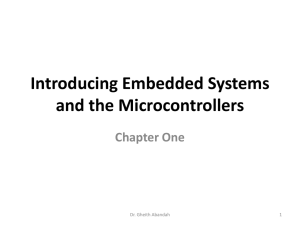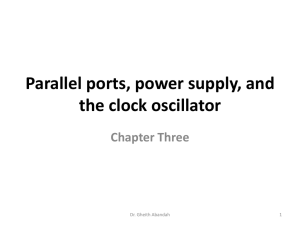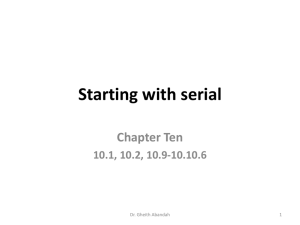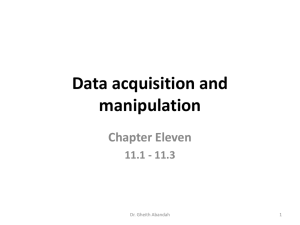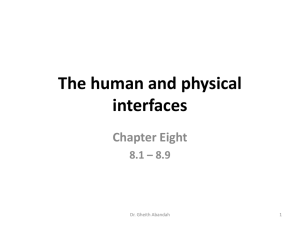ppt - Abandah
advertisement
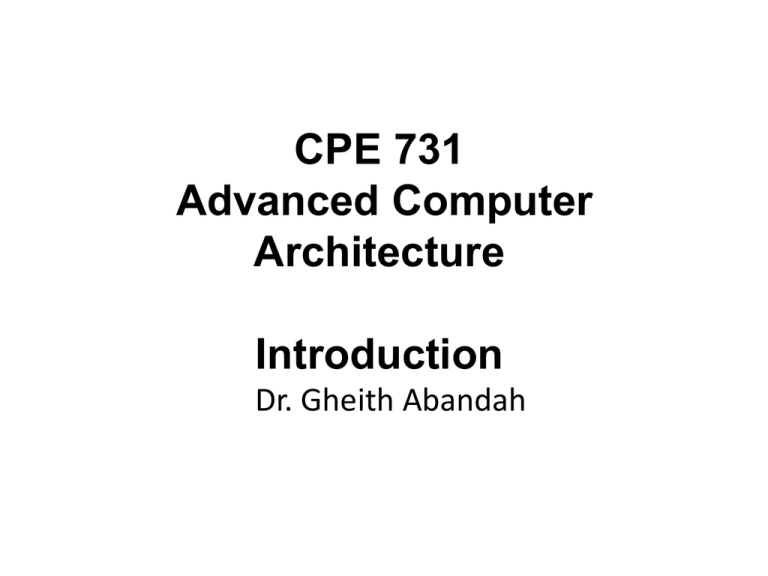
CPE 731 Advanced Computer Architecture Introduction Dr. Gheith Abandah Outline • Course Introduction – Course Information – References – Grading and Policies – Course Outline – Important Dates 2 Course Information • • • • • Instructor: Dr. Gheith Abandah Email: abandah@ju.edu.jo Homepage: http://www.abandah.com/gheith Office: Computer Engineering 405 Office Hours for Dr. Abandah: Sun Tue Wed • Prerequisites: 3 12:00 - 1:00 9:00 - 10:00 10:00 - 11:00 None References • Hennessy and Patterson. Computer Architecture: A Quantitative Approach, 4th ed., Morgan Kaufmann, 2007. • Patterson and Hennessy. Computer Organization & Design: The Hardware/Software Interface, 3rd ed., Morgan Kaufmann, 2005. • D. Culler and J.P. Singh with A. Gupta. Parallel Computer Architecture: A Hardware/Software Approach, Morgan Kaufmann, 1998. • J. Hayes. Computer Architecture and Organization, 3rd ed., McGraw-Hill, 1998. • Readings in Computer Architecture, Mark Hill (Editor), Norman Jouppi (Editor), Gurindar Sohi (Editor), Morgan Kaufmann Publishing Co., Menlo Park, CA. 1999 4 Selected Papers • • • • • Trace Cache: A Low Latency Approach to High Bandwidth Instruction Fetching by E. Rotenberg, S. Bennett, and J.E. Smith, Proceedings of the 29th Annual International Symposium on Microarchitecture, November 1996. First paper on trace caches. Combining Branch Predictors, S. McFarling, WRL Technical Note TN-36, June 1993. Proposes the gshare branch predictor, covers a few others. See also the paper by Yeh and Patt (below). Alternative Implementations of Two-Level Adaptive Branch Prediction by T.-Y. Yeh and Y. N. Patt. Proceedings of the 19th Annual International Symposium on Computer Architecture, June 1992, pp. 124-134. The classic reference on two-level branch prediction. Checkpoint processing and recovery: Towards scalable large instruction window processors. By H. Akkary, R. Rajwar, and S. T. Srinivasan. In MICRO 36, December 2003. Reordering without the reorder buffer. Implementation of precise interrupts in pipelined processors by J. E. Smith and A. R. Pleszkun. Proceedings of the 12th Annual International Symposium on Computer Architecture, June 1985, pp. 36-44. The original paper on reorder buffers and their alternatives. 5 Selected Papers – cont. • • • The Mips R10000 superscalar microprocessor by K. C. Yeager, IEEE Micro, April 1996. One of the first out-of-order microprocessors. Uses a merged physical register file (unlike the P6). The Alpha 21264 microprocessor by R. E. Kessler, IEEE Micro, Mar/Apr 1999. Another out-of-order microprocessor that also uses a merged physical register file. The 21264 was easily the fastest processor available when it came out. The "dual cluster" design that uses two copies of the register file to reduce the complexity and latency of the bypass network is particularly interesting. This paper also has a substantial discussion of the 21264 tournament branch predictor that's also described in the textbook. The Microarchitecture of the Pentium® 4 Processor by Glenn Hinton et al. Intel Technology Journal, Vol. 5 Issue 1 (February 2001). Description of the Pentium 4 microarchitecture by the chief designers, includes some comparisons with P6 and some justification of the deep pipeline/high frequency design goal. 6 Grading and Plicies • Grading – Midterm Exam – Research Report and Presentation – Simulation Project and Final Exam 30% 30% 20%+20% • Policies – Attendance is required – All submitted work must be yours – Cheating will not be tolerated 7 Course Content • Introduction • Review of Advanced Processor Designs • Instruction-Level Parallelism and Its Exploitation Midterm Exam • Limits of Instruction-Level Parallelism • Multiprocessors and Thread-Level Parallelism • Memory Hierarchy Design • Storage Systems Final Exam 8 Important Dates • • • • • • • • Sun 5 Feb 2012 Sun 4 Mar 2012 Sun 11 Mar 2012 Sun 25 Mar 2012 Sun 1 Apr 2012 Sun 15 Apr 2012 Sun 22 Apr 2012 Tue 15 May 2012 • Sun 20 May 2012 • Sun 27 May 2012 Classes Begin Research proposal is due Presentations of the research proposals Midterm Exam (3:30-5:00) Research report is due and start of presentations Simulation project proposal is due Presentations of the simulation project proposals Simulation project report is due and start of simulation project demonstrations Last Lecture Final Exam (3:30-5:00) 9


